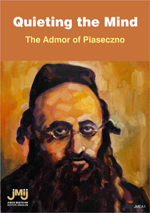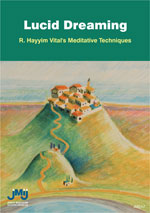 Synopsis: The “Quieting Technique” of the Admor of Piaseczno is a “user friendly” meditative method for transforming a “cluttered” mind into a peaceful inner state of awareness, thereby creating “space” to sense Divine Inspiration. The Admor suggests letting thoughts flow spontaneously etameditation) and non-attached, non-judgmental observation of inner ruminations and sensations (meta-cognition).
Synopsis: The “Quieting Technique” of the Admor of Piaseczno is a “user friendly” meditative method for transforming a “cluttered” mind into a peaceful inner state of awareness, thereby creating “space” to sense Divine Inspiration. The Admor suggests letting thoughts flow spontaneously etameditation) and non-attached, non-judgmental observation of inner ruminations and sensations (meta-cognition).
The method is to enter gently into a “near dream state”. He uses the metaphor of a broomstick that sweeps away the mundane stream of thoughts that preoccupy the mind, and thus facilitate a heightened ability for tranquil introspection, mental imagery and inner awareness. From the perspective of modern meditation research, this means reducing irrelevant synaptic clutter and disengaging from common modes of attention by entering a hypnagogic state. The Admor’s goal is to develop a soft form of non-ego focus creating room for a taste (1/60th) of prophetic inspiration.

 Maimonides (1138-1204), or Rambam in Hebrew, was a leading Rabbinic authority, codifier, and is considered the greatest Jewish philosopher of all times. In his magnum opus, The Guide to the Perplexed, he recommends a meditative focus to receive Divine Inspiration and Providence. He emphasizes the necessity of interpreting the Divine Influx by utilizing both cognitive analytical type thinking (what we call today left brain type thinking) and intuitive imaginative (right brain type thought processing). His meditative guidance in Guide to the Perplexed part III, chapters 51-52 opens with a parable of trying to enter the Sultan’s Palace. Some people simply are pointed in the wrong direction or don’t even know there is a palace. Others make their way to the doors, but not past the guards.
Maimonides (1138-1204), or Rambam in Hebrew, was a leading Rabbinic authority, codifier, and is considered the greatest Jewish philosopher of all times. In his magnum opus, The Guide to the Perplexed, he recommends a meditative focus to receive Divine Inspiration and Providence. He emphasizes the necessity of interpreting the Divine Influx by utilizing both cognitive analytical type thinking (what we call today left brain type thinking) and intuitive imaginative (right brain type thought processing). His meditative guidance in Guide to the Perplexed part III, chapters 51-52 opens with a parable of trying to enter the Sultan’s Palace. Some people simply are pointed in the wrong direction or don’t even know there is a palace. Others make their way to the doors, but not past the guards. This meditation has three parts. It begins with relaxation, settling down of the mind, freeing worries and creating inner joy. Next, we explore our “I”, discover our higher Self and transcend to an Inner Spiritual Freedom. The meditation concludes with gratitude and Shalom.
This meditation has three parts. It begins with relaxation, settling down of the mind, freeing worries and creating inner joy. Next, we explore our “I”, discover our higher Self and transcend to an Inner Spiritual Freedom. The meditation concludes with gratitude and Shalom. RLH is based on the mind-body-soul interactions and how “mirror neurons” may serve to reflect emotions/feelings of another.
RLH is based on the mind-body-soul interactions and how “mirror neurons” may serve to reflect emotions/feelings of another.
 The tanna Rabbi Meir draws a comparison of tekhelet to the sea, the heavens and the Divine Throne. R. Meir portrays tekhelet as a means of linking to and receiving the Shekhinah. Rabbi Aryeh Kaplan interpreted this as a powerful meditative technique to transfer one’s thoughts and awareness to heavenly domains. He speculated that this was used as a technique in mystical ascent to the Heavenly realms culminating in perception of the Divine Throne.
The tanna Rabbi Meir draws a comparison of tekhelet to the sea, the heavens and the Divine Throne. R. Meir portrays tekhelet as a means of linking to and receiving the Shekhinah. Rabbi Aryeh Kaplan interpreted this as a powerful meditative technique to transfer one’s thoughts and awareness to heavenly domains. He speculated that this was used as a technique in mystical ascent to the Heavenly realms culminating in perception of the Divine Throne.  R. Hayyim Vital developed a meditative type practice of cultivating dreams and utilizing a semi-sleep state. A main purpose was to facilitate reception of revelatory messages and Divine inspiration. In this booklet we examine several passages from The Book of Visions, his dream diary, and from Gates of Holiness, his ethical manual of how to attain prophecy.
R. Hayyim Vital developed a meditative type practice of cultivating dreams and utilizing a semi-sleep state. A main purpose was to facilitate reception of revelatory messages and Divine inspiration. In this booklet we examine several passages from The Book of Visions, his dream diary, and from Gates of Holiness, his ethical manual of how to attain prophecy.  Jewish Meditation & Neuro-Psychology
Jewish Meditation & Neuro-Psychology